US Department of Transportation
FHWA PlanWorks: Better Planning, Better Projects
Systems Management & Operations (SMO)
Plan Maricopa Association of Governments
PlanWorks
Maricopa Council of Governments' (MAG) development of its Systems Management and Operations Plan represents an excellent example of linking planning and operations. While MAG did not use PlanWorks to develop their SMO plan, the PlanWorks Linking Planning and Operations Application will be very useful in helping other agencies interested in this approach.
Executive Summary
- The MAG SMO Plan integrates operational strategies into the long range planning process.
- The SMO Plan was designed to feed into the next RTP and TIP updates and provides recommendations for integrating the SMO investment priorities into these processes.
- The SMO Plan identifies four priorities for investment: Integrated Corridor Management (ICM) Corridors, Regional Priority Arterials, Local Priority Corridors, and Regional Operational Strategies.
- A methodology was created to rank regional arterials for investment based on crashes, reliability, and VMT to ensure overall regional benefit.
- A robust performance measurement and reporting framework ensures accountability and builds trust for decision makers and the public to fund operational strategies.
The Maricopa Association of Governments (MAG) is the MPO for the Phoenix region. For many years the MPO focused on completing the planned regional freeway system and a new Light Rail Transit service to accommodate tremendous population growth. Over the past several years, focus has also shifted to transportation systems management and operations, or TSMO, building on the significant investments made by the region since 1996 in building advanced intelligent transportation systems (ITS) infrastructure.
MAG developed a Systems Management and Operations (SMO) Plan to guide strategic investment decision making for operational strategies. The development of the SMO Plan involved first identifying national best practices for prioritizing key corridors, and secondly developing a methodology to identify a hierarchy of regionally-significant corridors. Applying the methodology has resulted in a list of priority facilities in the region, along with other regional priority programs. Ultimately, the prioritized list will be included in the Regional Transportation Plan (RTP) and will be a driving factor in the development of the future MAG Transportation Improvement Program (TIP). The SMO Plan includes detailed recommendations on how to integrate the priority corridors and investment categories into the programming process, and provides a robust performance measurement and reporting framework to effectively communicate the benefits of operational strategies to the region.
Agency's Challenge
MAG serves the Phoenix metro area and is comprised of 27 incorporated cities and towns within Maricopa County and urbanized areas in Pinal County, as well as three Native American communities, covering an area of 10,654 square miles. The Phoenix region has experienced significant population growth over the past several decades, and is projected to continue to grow rapidly over the coming decades. By 2040, the region is expected to have approximately 6.5 million people, representing a more than 50% increase in population from 2015. [1] With this level of sustained growth, MAG realized that all available strategies for meeting the transportation demand must be utilized, including efficient system operations.
MAG was one of the country's early leaders in planning for operations, and since 1996 the MPO has integrated ITS projects into its regional transportation planning process. Since 1998, MAG has had a dedicated funding funding stream for ITS projects, relying primarily on Congestion Mitigation and Air Quality Improvement (CMAQ) Program funds, as well as several other regional transportation funding sources. Consequently, the region has made significant investments in building ITS infrastructure over time. While the Arizona DOT (ADOT) is responsible for the actual construction of freeway ITS projects, MAG is responsible for programming of regional funds for all freeway and arterial ITS projects in the TIP and has a selection process in place to include projects based on priorities set forth in the Regional ITS Strategic Plan.
- MAG's SMO Plan will provide valuable information and a basis for incorporating operations strategies effectively into the RTP and TIP updates as shown below.
- LRP-1. Regional SMO needs and priorities are available at scoping from the SMO Implementation Plan.
- LRP-2. A long-term SMO vision and concept of operations informs the regional vision.
- LRP-3. The SMO Plan contains a set of performance metrics for strategy and project evaluation as well as a performance measurement program for ongoing monitoring.
- LRP-5. MAG policymakers approved the methodologies for project prioritization and funding as outlined in the Implementation Plan. ICM Projects and Regional Operations Priorities will be funded programmatically as they represent region-wide priorities. Regional Priority Arterials and the Local Priority Corridors will be programmed using a project application process similar to the current TIP process.
- LRP-6. Operations strategies and projects are considered with other strategies in developing the RTP.
- PRO-3. Regional operational strategies will be funded and programmed as specific line-items in the MAG TIP or MAG Annual Work Plan. Many of them are already in the RTP.
Recognizing the critical importance of operational strategies to the region, the MAG ITS Committee recommended development of a Systems Management and Operations (SMO) Plan to provide guidance for the region in addressing future SMO needs for the next phase of building and operating the ITS infrastructure. MAG recognized the value of having a more systematic process for prioritizing transportation facilities and operational investments moving forward. MAG also recognized that in addition to funding ITS infrastructure, it also would need to provide financial support and invest in operations, such as agency staff resources for traffic management centers. This would be a major departure from past practices of only providing funds for building transportation infrastructure but not operations. Consequently, MAG undertook an effort to develop a SMO Plan for the region to help provide a framework for prioritizing these investments to improve the safety, efficiency, and reliability of the region's transportation system and to provide direction for future RTP and TIP updates.
Developing the SMO Plan
The process of developing the SMO Plan was led by a Technical Advisory Group (TAG) consisting of the MAG ITS Committee, leadership of the MAG Transportation Review Committee, staff from MAG member agencies (including ADOT), Valley Metro, and the Arizona Department of Public Safety. The TAG undertook a comprehensive process to develop the SMO Plan, starting with understanding best practices in transportation systems management and operations from around the nation. These practices, along with an inventory of current and near-term ITS infrastructure and SMO practices in the region, were used to construct a long-term vision and concept for SMO in the region. Four categories of funding priorities needed to implement the long-term vision in the RTP were identified, including Integrated Corridor Management (ICM) corridors, Regional Priority Arterials, Local Priority Corridors, and Regional Operations Priorities. Importantly, the TAG developed data-driven, repeatable methodologies to identify high-priority facilities and operational strategies within each of these categories, which will be used during the programming process to prioritize projects. The resulting list of facilities and strategies was used to develop specific recommendations and estimated costs for SMO strategies and projects to be prioritized for investments in 2021-2030, as well as for inclusion in the next RTP. The SMO Plan emphasized accountability through recommendations for robust data collection, performance measurement, and reporting processes.
The phases of the development process and how they fit together is described in more detail in the following sections and is illustrated by Figure 1 below.
Figure 1. SMO Project Plan Process and Inputs
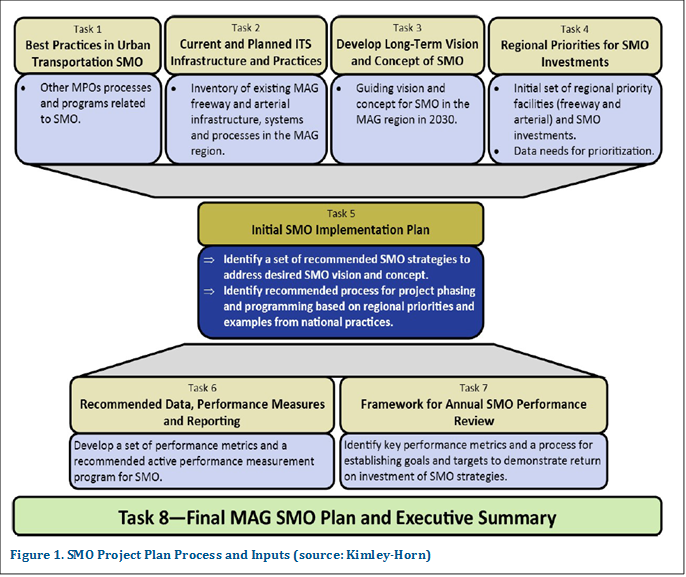
(source: Kimley-Horn)
Synthesizing National Best Practices
MAG examined SMO practices from across the country to identify the most effective practices and synthesize lessons learned that could be incorporated into the SMO Plan, both with respect to supporting the management and operation of their transportation systems, as well as the integration of SMO into planning and programming. Best practices were compiled using using a web-based survey of experts to identify exemplary SMO practices, followed by interviews with MPOs that were comparable to the MAG region and had effective practices, and a literature review encompassing resources from the Federal Highway Administration, the National Operations Center of Excellence, and the National Cooperative Highway Research Program.
The key findings from this synthesis included:
- The SMO plan was recommended to be a "living document," with frequent updates to ensure that it reflects the latest state of operations and technology.
- Linking the SMO Plan to other plans such as the RTP and/or the Congestion Management Plan was also cited as providing benefits to other agencies by aligning efforts across the region.
- Expanded use of performance measures, more funding for traffic incident management and traffic signal operations, greater use of before and after studies to make the business case for operational improvements, and the development of corridor investment strategies were also recommended for the MAG region.
Reviewing Existing and Planned ITS Infrastructure and SMO Practices
MAG prepared an inventory of existing and proposed highway and arterial ITS infrastructure, as well as current SMO practices in the region. Coverage and features were the specific attributes collected for infrastructure, whereas systems, business processes, staff training, benefits, and return on investment were considered for SMO strategies in use in the region. The inventory was prepared by means of electronic surveys covering freeway operations and management; arterial operations and management; and regional SMO functions and operations. Different surveys were sent to ADOT, which manages the freeways, and the local agencies in charge of arterials across the MAG region. The inventory laid the foundation for an analysis of gaps in infrastructure, systems, and processes that needed to be addressed in the SMO Plan. The key areas of improvement brought out by the inventory include the ability to collect and process real-time transportation data to monitor system performance and make operational decisions; better asset management and lifecycle planning; staff training, especially in the area of real-time traffic management and incident response; and a better understanding of how to incorporate emerging technologies into planning, including through more flexible procurement mechanisms and partnerships.
Figure 2. 2030 Vision for MAG Regional SMO
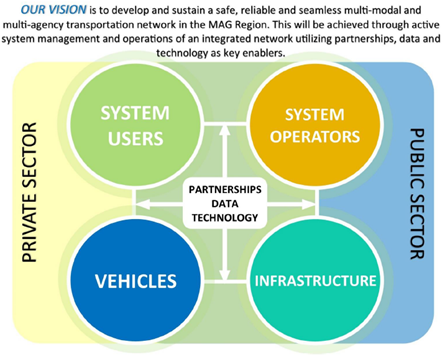
Creating a Long-Term Vision
A long-term vision was created for how SMO in the region should look in 2030, including development of a Concept of Operations addressing improvements likely to emerge by 2030. Extensive stakeholder input went into the process of creating the vision, including visioning workshops with TAG members, electronic surveys of local agencies, and an expert panel of industry experts. Additionally, the vision incorporated infrastructure improvements and road construction projects in current MAG plans, including the RTP and the projects planned to be funded by the Proposition 400 half-cent sales tax. The resulting vision and concept of operations identified several key operational objectives for future SMO in the MAG region, including continued focus on ICM, identifying ways to expand operations coverage for key arterials in the region, and making provisions for future technology and partnerships to advance SMO objectives.
Identifying Regional Priorities for SMO Investments
A critical step in the SMO Plan process was the development of an approved methodology for prioritizing areas of investment, including development of a hierarchy of regionally significant roadways and operational priorities. The main idea behind the development of this list was that "projects and resources that will have the most influence toward reaching the SMO vision and goals be given priority in the programming and implementation processes." [2] Four categories of funding priorities were identified for consideration in the RTP, representing investments that will increase system efficiency, reliability, and safety. The four categories together address high-priority regional corridors, build up local agency systems, and establish regional operational capabilities. The categories as defined in the Plan are:
Figure 3. Categories of Funding Priorities for the SMO Plan
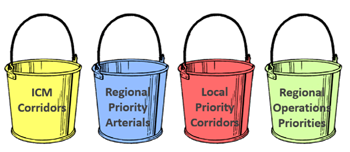
- Integrated Corridor Management (ICM) Corridors — includes all freeways in the MAG region and the adjacent arterial corridors (and crossing arterials) that provide direct support for the freeway as a detour route.
- Regional Priority Arterials — consists of those corridors that are identified as regionally-significant based on a data-driven assessment using crash, travel time and vehicle-miles-traveled as criteria.
- Local Priority Corridors — includes roadways that are identified by local agencies as priorities, but do not fall in to the ICM or Regional Priority Arterial categories. Funding should be available for local projects similar to the current TIP programming process.
- Regional Operations Priorities — consists of regional activities and initiatives to support operations at a regional level, including programs such as staffing for sub-regional traffic management centers (TMCs), training, Traffic Incident Management (TIM) initiatives, and regional Intelligent Transportation Systems. [3]
The methodologies for each category were presented to and approved by the TAG as well as MAG policymakers. For each of the investment categories above, a set of strategic projects or strategies was generated using the methodologies, with the intention of incorporating them in the upcoming RTP and TIP.
ICM Corridors - The SMO Plan recommends using the methodology currently used to prioritize freeway investments in the MAG planning processes for ICM Corridors. This ensures that SMO priorities are in alignment with freeway priorities outlined by ADOT; with the intent that future operational and ITS upgrades on these segments will be done in concert with similar upgrades to supporting arterials. Using this approach, a set of priority ICM corridors were identified (shown in Figure 4), to be used for planning purposes, with each agency responsible for identifying specific arterials and detour routes that will be included for the ICM corridors in their jurisdiction.
Figure 4. ICM Corridors Identified in the MAG region
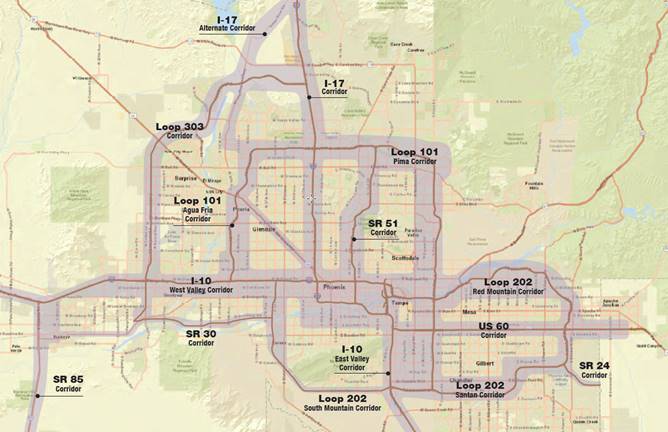
(source: Kimley-Horn)
Regional Priority Arterials - The Regional Arterial Priority Methodology was designed to be data-driven and repeatable, and consisted of a four-step process as follows:
The first step involveed using geographical information systems (GIS) to develop and identify arterial segments for evaluation. These segments were three to six miles long, and were intended to be uniform with regards to traffic volume or crash occurrence. Some of the characteristics used for developing segments included land use, the location of major employment and activity centers, traffic volumes, average peak period vehicle speeds, and the number of travel lanes. [4] The GIS layer with the segments is expected to be updated in future years to account for changes in the transportation network.
The second step was to evaluate segments against prioritization criteria . The three metrics chosen were crashes per mile per year, maximum travel time index, and average VMT per mile. Each metric reflected one of the SMO goals, namely safety, reliability, and mobility. The metrics were normalized to a five-point scale, which was used to generate a score for each segment, consisting of the sum of the score for each of the three criteria. Scores were tallied in a Microsoft Excel table.
Sorting the segments by descending order of score resulted in a ranked list of priority segments . A set of the top 100 regional priority arterials were identified (shown in Figure 5 below), highlighting the arterial segments and corridors that were of regional interest and would benefit from regional-level investments.
The final step consisted of exporting the top 100 segments back into GIS, and identifying additional segments to be included to create priority corridors . These included gaps between segments, or corridors with high transit or freight value.
The list of top 100 arterials is intended to be reviewed and updated based on the latest data prior to each TIP programming cycle.
Figure 5. Top 100 Arterial Segments by Score
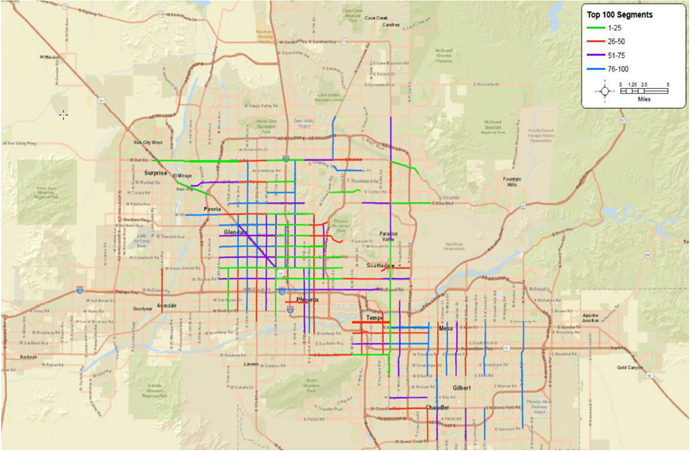
Local Priority Corridors - Local Priority Arterials were not identified in the SMO Plan. Instead, the TAG recommended setting up a mechanism by which local agencies can submit SMO projects for competitive funding in the TIP, similar to the current process for ITS projects.
Regional Operational Priorities - Priority strategies for Regional Operations were identified, focusing on those that benefit the regional transportation system as whole, rather than isolated projects on local roads. These strategies include existing MAG programs—such as the Traffic Signal Optimization Program (TSOP)/Signal Timing Program, regional arterial incident response and management program, and Freeway Service Patrol (FSP) program—as well as new recommended strategies such as regional after-business hours TMC support, enhanced traffic incident management (TIM) program strategies, a regional connected and autonomous vehicle strategy, and integration of transit data and systems to facilitate transit coordination during incidents/ICM, among others. Funding for these regional operations strategies are recommended to be one or more specific line-items in the MAG TIP.
Establishing Performance Measures and Reporting Processes
The SMO Plan provides recommendations for establishing an active performance management program at MAG related to the SMO Program and generation of performance reports on SMO for the region. The Plan makes recommendations for performance metrics across the four investment categories, with the exception of local priority arterials, which are funded by local agencies and are not under the purview of the SMO Plan. It is envisioned that performance reporting will occur on an annual basis and track progress towards regional SMO goals. There will likely be several performance tracking activities at the micro level, both corridor- and application-specific, to monitor the effectiveness of strategies on a corridor.
The MAG region relies on a half-cent sales tax raised under Proposition 400 to fund a large portion of the transportation system, which has traditionally been focused on infrastructure improvements. As this Plan represents the first time that funding is being used for operational strategies, many of which need to be funded annually, the importance of proving the effectiveness of these strategies (and in turn, good use of public money) is emphasized in the recommendations. Project evaluations are a good tool to show outcomes and returns on investment. For example, a recently completed three-year pilot project for efficient traffic incident management on freeways, jointly funded by MAG and ADOT, called for the co-location of Department of Public Safety Officers at the ADOT Traffic Operations Center. This project was evaluated by MAG and found to yield a benefit-to-cost ratio of 258:1. This finding was instrumental in permanent funding being allocated to the colocation and expansion of services 24/7 for the entire state of Arizona.
Well-designed, easy-to-understand reports with compelling graphics can provide accountability and easily communicate the regional benefits to safety, reliability, and efficiency to MAG decision-makers, stakeholders, and the public. A framework for an Annual SMO Performance Report was laid out, containing an overall dashboard, regional performance indicators, details on investment priority areas with "stories" to illustrate their regional impacts, and a concluding section linking SMO performance with other MAG activities.
Implementation: Linking Planning and Operations
The Implementation Plan lays out a blueprint for operationalizing the SMO Plan by suggesting recommended projects and strategies to be considered for investment during the 2021-2030 period and inclusion into the next RTP, along with estimated investment levels totaling $205 million. This was done in order to provide an idea of the long-term commitment required to operationalize the SMO vision. Of this, 72%, or $147 million, represents one-time infrastructure or system deployment costs that can be programmed for a specific year and do not require recurring costs in the RTP. The Implementation Plan also lays out processes for programming the recommended projects and strategies into the next update of the TIP; the first TIP to be programmed using the SMO vision is likely to be for 2021.
Figure 6. SMO Plan Implementation Timeline
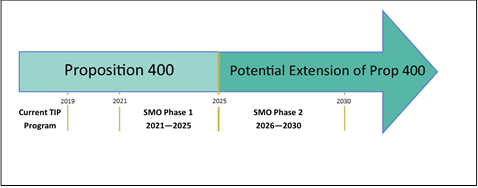
Both the current RTP and Proposition 400 expire in 2025. The SMO Plan has recommended a timeline for implementation that takes into account the end of the current RTP, development of the next RTP, and funding programmed under the current TIP. This takes into account projects already planned under the RTP/TIP, which include $8 million for freeway ITS projects per year until 2021 but no funding for arterial ITS projects after 2019.
The Implementation Plan recommends two processes for programming the four investment categories. The ICM Projects and Regional Operations Priorities will be funded programmatically and accounted for annually as they represent region-wide priorities that involve multiple agencies. For the ICM Corridors, the priorities identified in the SMO Plan match the priorities of Arizona DOT, and the projects are clearly identified and can be easily programmed. Funding has already been programmed through 2020 for completing the freeway management system that will provide the base requirements for ICM specified by the TAG.
Regional operational strategies will be funded and overseen at the regional level and programmed as specific line-items in the MAG TIP or MAG Annual Work Plan. Many of them are already in the RTP, like the Freeway Service Patrol or the Traffic Signal Optimization Program, and are renewed annually; new strategies that are not near-term priorities will be programmed after 2021 and funded through 2030. However, staffing support for after-hours arterial TMC operations was deemed to be a near-term priority that should be funded prior to 2021.
The Regional Priority Arterials and the Local Priority Corridors will be programmed using a project application process similar to the current TIP process. Each year, the MAG ITS Committee may designate either a number of segments that will be pursued or an amount of funding that will be allocated to regional priority arterials to undertake SMO projects recommended in the Plan. These projects will be analyzed using the ranking methodology developed as part of the Plan; the process is intended to be analytical and data-driven, feeding the past 5 years of data into the methodology to identify the arterials that rank the highest for investment. Because the data changes every year, the rankings and arterial priorities may change accordingly. Prioritization of segments then would be based on the ranking of the segment in the top 100 ranking exercise, with additional factors such as agency capacity to undertake the project and opportunities to leverage other projects that may be occurring on the facility, such as by transit or freight.
The Implementation Plan recommended that $3 million be allocated annually for Local Corridor Priorities, and allocated based on call for projects as is currently done for local ITS projects. New funding for this category will begin in 2021.
Key Outcomes
MAG's recognition that SMO approaches are a crucial piece in improving system safety, efficiency, and reliability has resulted in a comprehensive plan to prioritize SMO projects in the transportation planning process. By clearly identifying the investment categories, priority corridors, and operational strategies required for the region along with their funding requirements, the MAG SMO Plan sets out a clear roadmap for how SMO can benefit the region and what needs to be done to make this vision a reality. The SMO Plan was developed to feed into the RTP and TIP processes, and the inclusion of recommendations for programming processes as well as timelines aligned with current plans should ensure successful SMO implementation throughout the region.
For More Information
Contacts
Margaret Boone, PEITS & Safety Engineer 3
Maricopa Association of Governments
MBoone@azmag.gov
